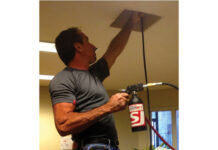Mold is a fungus that thrives in damp and humid environments like basements. For homeowners, this can be a serious issue as mold can cause severe health problems and may even damage building materials, weakening the structure of the basement. Identifying the presence of mold in the basement and addressing it is essential for the health and safety of the occupants.
Understanding how to prevent and handle mold growth in a basement is necessary for maintaining a healthy home environment. When recognizing the signs of mold growth, homeowners should be aware of musty or earthy odors, visible mold growth, and increased allergy symptoms. Without prompt removal, mold spores can quickly spread, exacerbating health problems.
In addition to cleaning the affected area and using appropriate cleaning agents and equipment, addressing the underlying causes of mold growth, such as water leaks or poor ventilation, is also necessary to prevent future infestations. If the problem is severe or widespread, consult with permanent mold removal experts for safe and effective removal. This article will discuss how to identify, prevent, and handle mold growth in a basement.
Understanding Mold
Mold is a type of fungus that grows in damp and humid environments. It reproduces by releasing spores that can travel through the air and settle on surfaces, where they can grow and spread.
Causes Of Mold Growth In Basements
Basements are prone to mold growth because they tend to be damp and poorly ventilated. Common causes of mold growth in basements include:
1. Water leaks or flooding
Moisture, water leaks, or flooding caused by heavy rain, broken or leaky pipes, faulty appliances, ground seepage, condensation from humidity, improper ventilation, insufficient drainage, and a lack of proper home insulation are all common causes of mold growth in basements.
2. Condensation on pipes, walls, or windows
Condensation can cause mold growth in basements by providing a moist environment for spores to thrive. This can occur on pipes, walls, or windows due to poor ventilation and too much moisture in the air. Basement appliances that produce water vapor can also contribute to mold growth.
3. Poor Ventilation
Basements are prone to high humidity levels and poor air circulation due to their lack of windows. This creates an environment ideal for mold growth as damp air condenses on the walls and floor and cannot move out.
Types Of Mold Commonly Found In Basements
Many types of mold can grow in basements. Some of the most common types include:
- Cladosporium: a green, brown, or black mold that grows on fabrics, carpets, and wood surfaces
- Penicillium: a blue or green mold that can grow on a variety of surfaces, including wallpaper, carpet, and insulation
- Aspergillus: a yellow, green, or black mold that can grow on damp materials, such as paper and insulation
- Stachybotrys: a black mold often associated with water damage and can cause serious health problems if left untreated.
Signs Of Mold In Your Basement
The most apparent indications of mold in the basement are visual signs such as fuzzy, discolored patches on walls, floors, or ceilings, black or green spots on surfaces, or a white powdery substance on wood or paper. Mold has a musty odor, so a noticeable smell in the basement should also be investigated for its source.
One factor that contributes to mold growth is excessive moisture. Therefore, it is essential to maintain ideal basement humidity levels. Proper humidity control in your basement can significantly reduce the risk of mold growth and ensure a safe and healthy living space for you and your family.
In addition, health symptoms such as nasal and sinus congestion, sneezing, coughing, wheezing, eye irritation, skin irritation, headaches, and fatigue can indicate mold exposure. It is important to investigate the source and take steps to address any mold growth if any of these signs or symptoms occur in your basement.
Preventing Mold Growth in Your Basement
To prevent mold growth in your basement, controlling moisture levels is essential. This can be done by fixing leaks and water damage, using a dehumidifier and sump pump, and properly insulating the basement.
Additionally, proper ventilation is key. Use fans to circulate air, keep windows open when weather permits, and avoid overcrowding with furniture and boxes. Lastly, performing regular inspections is necessary to detect any potential mold growth. Look for water damage or signs of mold, and test the air quality with a mold testing kit.
Handling Mold In Your Basement
Taking immediate action is important if you discover mold growth in your basement. Permanent mold removal experts can help effectively remove the mold and ensure it does not spread.
Basement Waterproofing is also a crucial aspect of preventing mold growth in your basement. By ensuring that your basement is properly waterproofed, you can reduce the risk of water seepage and moisture buildup, which are common contributors to mold growth. Waterproofing solutions may include sealing cracks and gaps in the foundation, installing sump pumps, and improving drainage around the exterior of your home. Investing in basement waterproofing not only helps prevent mold but also enhances the overall structural integrity of your home, providing a healthier living environment for you and your family.
This may involve containment of the affected area, the removal of damaged materials, the use of specialized equipment to remove and clean mold-infested surfaces, and the application of antimicrobial treatments. Taking these steps can help protect your home from further damage caused by mold.











